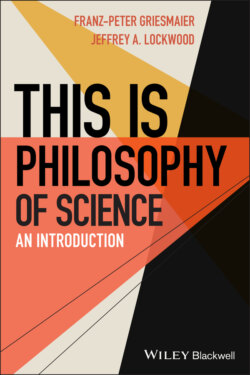Читать книгу This is Philosophy of Science - Franz-Peter Griesmaier - Страница 42
3.3.1 Progressive Modifications
ОглавлениеHowever, we have also seen that due to the role of auxiliary hypotheses in theory testing, conclusive falsification is not possible either. A hypothesis can always be protected against falsification by denying one or more of the auxiliary hypotheses; in principle, one can even deny the observational statement with which the hypothesis has been found inconsistent. In the early 1800s, English chemist William Prout proposed that the atomic weights of the various elements are whole multiples of the atomic weight of hydrogen. It was well known though that some elements appear to have weights that are inconsistent with Prout’s hypothesis. Chlorine, for example, was measured to have 35.5 times the weight of hydrogen. Prout remained undeterred and suggested that the chemical processes used to isolate elements were defective, and thus the chlorine sample was impure. In this case, assuming the truth of the main hypothesis was used to criticize and consequently modify the then prevailing experimental techniques that produced observational statements.
This raises the question of how one should decide what to modify in light of an inconsistency between theory and observational statements: the main hypothesis, one or more of the auxiliary hypotheses, or the observational statements which are based on the experimental techniques producing them? As an answer, Popper proposed that any modifications made should increase the falsifiability of the resulting theory. Since falsifiability is a measure of content – the more falsifiers a theory has, the greater its content – this amounts to the advice to modify in the direction of greater content, by either being broader in scope or more precise.
As an example, consider the theory C that all orbits of celestial bodies are circular. This theory is of broader scope than the theory P that all orbits of planets are circular, since planets are a particular kind of celestial body. Having broader scope, it has more falsifiers. On the other hand, it is also more precise than the theory E that all orbits of celestial bodies are ellipses, because circles are a kind of ellipses. Thus, C has more content than both P and E – it has more content than P by being more universal, and it has more content than E by being more precise.
Popper claimed that modifications that increase a theory’s falsifiability contribute to the progress of science. The intuition behind this claim seems to be this: If we protect a theory from falsifications by modifying it in a nonfalsifiable way, scientific development comes to a stand still. Yes, the current theory has been protected from falsification, but at the expense of stagnation. It’s like going into the corner and pouting. Here’s a sports analogy. Suppose you have been beaten at your favorite sport. Sure, you can look for excuses – the referee was unfair, there was too much wind, the ball was rigged, etc. And since these things seem to be always happening, you won’t play anymore. But if that’s your reaction, you clearly won’t make progress. Maybe the better strategy is trying to improve your game and then compete as hard and as often as you can, which of course increases your opportunities of being beaten. If you then stay unbeaten in ever tougher competition, it seems like you’ve made progress, certainly more than you could have made by frowning in the corner and not playing again. Of course, even if you stay unbeaten for a long time doesn’t mean that you are a perfect player; there might still be better ones out there. But you have earned your right to play on for a while, to be kept on the team, as it were. And what goes for sports, Popper thinks, goes for theories. If we expose them to severe competition with other theories through tests, the ones that keep on winning earn their keep.
As mentioned earlier, Popper’s technical term for staying unfalsified through severe tests is being corroborated. The corroboration of a theory does not provide a reason for believing it to be true, or even probable to any degree. Rather, it means that it has survived varied and severe tests, where severity is a function of the number of potential falsifiers for a theory. Assigning corroboration is simply saying that the theory is consistent with a set of statements that are currently accepted as basic. Thus, the degree of corroboration of a theory can change with changes in bodies of accepted basic statements. It is therefore clearly not a sort of truth value, because the truth of a statement is not in this way relative to what other statements are accepted.
